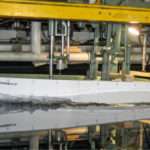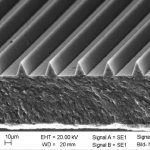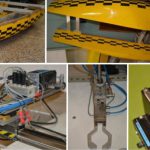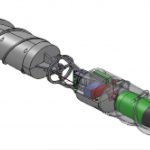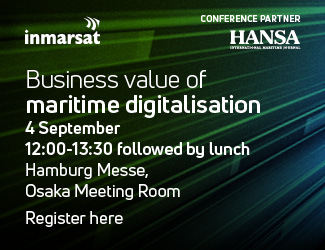New ideas for vessel design, propulsion and increased efficiency were presented at this year’s Symposium on High-Performance Marine Vehicles (HIPER). Inspiration for innovative future technologies comes from the past and from biology, writes Felix Selzer
Researchers, engineers and IT experts from all around the world gathered in Cortona, Italy, for the 10th Symposium on High[ds_preview]-Performance Marine Vehicles. The research and working projects presented covered all the hot topics of today’s shipbuilding: efficient design, construction and operation, autonomy, new materials and unconventional design approaches.
The need of the shipping industry to comply with stricter environmental regulations, and to stay competitive in a challenging business environment are driving change and should make the industry more open to new ideas. A key aspect of HIPER surely was efficiency: efficient design, efficient manufacturing and efficient operation.
Unconventional, better results
Better ships start with better design processes and methods. Unconventional approaches will be necessary not only in highly specialized sectors such as naval shipbuilding, but also for the ever increasing complexity of vessels. David Andrews of Marine Research Group, UCL, predicted more unconventional ship design to come in the future, also enabled by simulation-based design. To offer faster and more accurate results, simulation software companies open up to a more cooperative approach. Thomas Hildebrandt of Numeca presented a successful attempt of hydrodynamic optimization of a boat’s hull »in the cloud« for faster turnaround times, using software from different providers for parametric modelling and hydrodynamics. Taking the collaborative approach to the next level, Henrique Gaspar of NTNU even created an open source application for a conceptual ship design library (see also HANSA 9/2016).
»As ship designers we should be more proactive about ship requirements.« David Andrews, UCL
Computational Fluid Dynamics and Virtual Prototyping makes re-thinking of design approaches easier – and allows for maverick ideas. Using different CFD simulation tools, Prasanta Sahoo of Florida Institute of Technology researched the drag reduction and seakeeping improvement capabilities of Hull Vane, hydro foil, in combination with high speed displacement hulls. The device is a fixed foil below the waterline, aft of a vessel. The vertical force of the foil can reduce the running trim of the vessel. A similar problem was addressed by John Almeter of the US Naval Surface Warfare Center. He found performance gains could also be achieved through a longitudinal concave camber in planing hulls, that improves the lift to drag ratio.
How about a hull that can be adapted to changing requirements? Andreas Wulf of Fraunhofer IFAM presented a project researching inflatable flow resistors that can change the hull’s shape in certain locations of a vessel. The idea is to take into account flexible operational profiles of modern vessels and to improve overall efficiency.
»Virtual Reality and Infinite Computing are the key to our work. We don’t have it, yet.« Nick Danese, NDAR
And the innovation in hull forms continues: Alberto Calderon of Transonic Hull Company has developed a new »Subductor Hull«. It induces a hydrodynamic subduction process by which the gravity bow wave of a conventional vessel is replaced by a weaker submerged current that surfaces as a placid wake. According to Calderon the absence of a bow wave eliminates its collision with sea waves and enables the slicing – not piercing – of waves into right and left sides without disturbing their energy, therefore being shock and slam free. The hull’s structure is also lighter and less complex than conventional ships and allows for reduced construction costs.
With »Monotricat«, Luigi Mascellaro presented an invention that combines a beneficial new hull shape and air bubble approaches. Initially developed for naval vessels, the hull is flanked by two side blades. The thin central bow creates waves and spray, which are forced between the blades, lifting the stern. According to Mascellaro fuel savings up to 20% have been certified.
Air lubrication and coatings
Meanwhile, the air bubble technology – pumping air through the bottom of the ship’s hull to create a bubble carpet – seems to have matured further. Noah Silberschmidt, CEO of Silverstream Technologies, presented his solution that has already been introduced to the market. Since early 2015, Dannebrog’s 40,000 dwt products tanker »Amalienborg« successfully uses the retrofitted air bubble system with consistent 4% fuel savings. Cruise vessel »Norwegian Joy«, under construction at Meyer Werft, will be the first newbuilding featuring the technology. Silberschmidt, who was awarded the »HANSA Maritime Innovator Award«, that was given away for the first time (see also HANSA 11/2016), knows how long the process for innovations to get accepted can be: »We started six years ago, now it is starting to become a profitable business.«
Ichiro Kumagai from Meisei University and his colleagues from Japan and Australia also developed an air bubble system that can produce net power savings of 5–15%. The technology uses angled hydrofoils with air introducers. The low pressure region above the hydrofoil drives atmospheric air into the water. No bubbles but air cavities under the ship’s hull are also said to offer significant reduction in energy consumption. Comparing this technology to other air systems. Cornel Thill of Delft University of Technology even sees »ACS« as the most promising one. Giorgio Trincas of the University of Trieste and Russian researches from Krylov State Resarch Centre presented their engineering and economic analysis of ACS. For a 9,500 TEU container vessel they calculated annual fuel savings for the last year in the range of 1.0–1.5mill. $.
»The sector is conservative. If you want to talk about new technologies, you have to soften them up a little bit.« Gabriel D. Weymouth, University of Southampton
Reducing frictional resistance was one of the main topics of this year’s HIPER. While some researched the capabilities of new hull shapes, others took a closer look at marine animals’ skin properties. A lot can be learned with regard to drag reduction and maybe even fouling resistance.
James W. Gose of the University of Michigan and his colleagues took inspiration from the lotus leaf to experiment with super-hydrophobic coatings. In their tests they were able to show, that surfaces combining a low surface energy material with nano and micro scale roughness provide sustained skin-friction reduction in turbulent flows.
Another natural example for low friction surfaces can be found in the skin of sharks. Volkmar Stenzel on behalf of a group of Fraunhofer IFAM researchers presented their findings on the properties of riblet-coatings mimicking sharkskin and by that reducing drag by more than 5%. They also took a look at dolphin skin, which are efficient in order to postpone transition from laminar to turbulent flow. The latter was also looked at by Lars-Uve Schrader of Hamburg Ship Model Basin (HSVA). Dolphins have a soft skin which is believed to delay transition from laminar to turbulent flow by stabilization of the laminar boundary layer through the pliable surface.
Diego Meseguer Yebra of coating manufacturer Hempel shared his view on research and development directions to reduce hull friction in the future. His conclusion: To keep surface roughness to a minimum ships will likely be fully blasted and re-coated in the future in shorter intervals. Compared to the added fuel cost of only partial patching, he sees a positive business case for that. Until then, hull cleaning methods and anti-fouling formulations will develop further.
Wind is back on the agenda
Some engineers and researchers keep looking at the force that powered shipping for thousands of years: wind. While it is obvious that modern cargo vessels, routes and schedules do not allow for pure sailing solutions, sails can be used as a fuel saving device. Jarle Kramer of NTNU Trondheim presented how he and colleagues analysed the advantages and disadvantages of Flettner rotors. This old technology has already showed potential for fuel saving, although depending on vessel type and routes, which was also demonstrated by Rogier Eggers of Maritime Research Institute Netherlands (MARIN). He presented his findings from the EU funded »Wind hybrid Coaster« project that researched Flettner technology potentials for a new type of »green« coastal ship.
Morgan Behrel, ENSTA Bretagne, looked at the performance of kite sails that has been tested in full scale on a trawler. Experimental and parametrical data served to develop reliable methods to estimate lift-to-drag ratio. Further tests are to follow.
Wind propulsion reoccurred at another point of the conference, when research projects in the area of autonomous shipping were discussed. Smaller applications, sailboats that cross the ocean without external help or tow cables without disturbing sea life, demonstrate the capabilities of wind propulsion to make ships operate independently.
The Mayflower project of British company MSUBS, presented by Brett Phaneuf, once again showed the capabilities of wind propulsion (see also HANSA 9/2016). This time in combination with solar panels to enable independent crossing of the Atlantic Ocean. The sail and solar applications may be small scale but they do have implications also for commercial shipping as assisting technologies for more efficiency at sea.
Inspiration from nature
»The distinguishing factor of biological systems is their flexibility in shape, thrust and direction«, said Gabriel D. Weymouth, University of Southampton, says. He is an expert, when it comes to technical solutions inspired by biology. He likes to compare conventional underwater vehicles to fish or seals: Man-made devices are often »shaped like a brick«, unable to react quickly and flexible, Weymouth said. Even the torpedo-shape is not an optimal choice as he demonstrates. Researching the fast start capabilities of squids, he presented a soft-bodied robot that, by expansion and contraction, can move water far more efficiently than a propeller can.
How flexible body shapes can also be used demonstrated Marcis Eimanis of the Institute of Mechanics in Riga. He and his colleague Janis Auzins built an autonomous underwater vehicle (AUV) that was inspired by the flagella that some bacteria use for moving around. In this case, propulsion force is created by the threaded, counter-rotating bow and stern parts of the device. The joint in between is flexible in all directions, allowing for fast changes of speed, direction and thrust. Some of these aspects have been investigated by Yasuiuky Toda and fellow researchers from Osaka University, who have developed a squid-like underwater robot, propelled by two undulating side fins. The system follows the swimming mechanism of flat fish, such as squids, cuttlefish or rays. Again, the animals’ ability to instantly change their attitude was an important factor.
Also the mechanisms inside living organisms can be a model for marine engineering solutions, Enrico Ravina, University of Genoa, demonstrated. He developed pneumatic muscles for rudder actuation and pointed out the overall benefits, that pneumatic systems have over the conventional hydraulic systems: lighter, less parts, lower risks, longer life and better reliability.
New materials and unmanned ships
If you discuss ships of the future, you cannot ignore materials and construction methods of the future. Max van der Zalm of Delft University of Technology gave an overview of todays 3D printing capabilities. While cost-effectiveness and knowledge gaps still limit the adaption on the technology, especially in the structural area, there are promising results. But once adapted and accepted, 3D printing has the potential to dramatically change supply chains. Plus: it offers more freedom of design and fast prototyping results.
Composite materials also offer al lot of freedom to designers and engineers, as was pointed out by Julien Sellier of STRUCTeam. He saw great benefits in using lightweight materials in shipbuilding – after all, their durability has long been proven in other areas of application such as offshore wind turbines.
Not only materials and manufacturing will change, also assembly in shipyards. Florian Beuß of Fraunhofer AGP brought a case study to Cortona, looking at the benefits of modular design. Prefabrication of modules does not only save money, it improves safety and workers’ health by more ergonomic assembly processes.
»IoT is a buzzword, but it is growing out of a buzzword into a market.« Andrea Romano, Dell
And change in the shipyards will come in a foreseeable future, said Nick Danese of NDAR, who together with SSI identified several drivers. Besides customer requirements, he sees the current state of the market as beneficial for innovation: »If we look at history, most companies innovate out of desperation, not when times are good.« Getting rid of traditions and embrace change might be necessary to stay on top of the industry now.
No conference on the future of shipping would be complete without discussing autonomous shipping. Smaller crews on more efficient, maybe wind-assisted and more intelligent ships will certainly be one of the steps towards that future, said conference organizer Volker Bertram, after Teus van Beek of Wärtsilä had presented his company’s bold visions for the future. Even submerged, hydrogen-powered cargo vessels were included (read more on pages 70–71). Actually enabling autonomous operation while using today’s technology was the approach of Qinetiq. Darren Haliday presented the company’s concept for an autonomous firefighting vessel, to be deployed in oil fields (read more in the next HANSA issue).
The first »HANSA Next-Generation Innovator Award« went to Susanna Valenti and Enrico Ravina. They developed the concept for a fleet of autonomous units that can remove oil from the sea surface, managed by a waste recovery island. The autonomous vessels use wool mats to catch all sorts of oil that can be reused after recovery (see also HANSA 11/2016).
Andrea Romano of Dell came to HIPER with a message to the shipping world: You have the technology and sensors to collect data from the vessels, computer companies have the knowledge to get value out of that. The maritime industry should team up with the digital experts, Romano said.
While some of the projects that were presented presented have already developed into veritable business cases, others still are ideas in the research phase. But since the purpose of HIPER conference is not to discuss technologies of today but of the future, it is worth looking out for new real-world applications in the years to come. »Our younger colleagues still have to learn the power of the word ›yet‹«, Volker Bertram put it.
Felix Selzer





